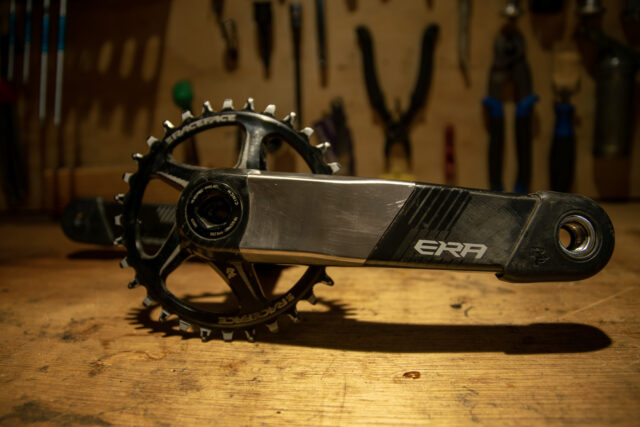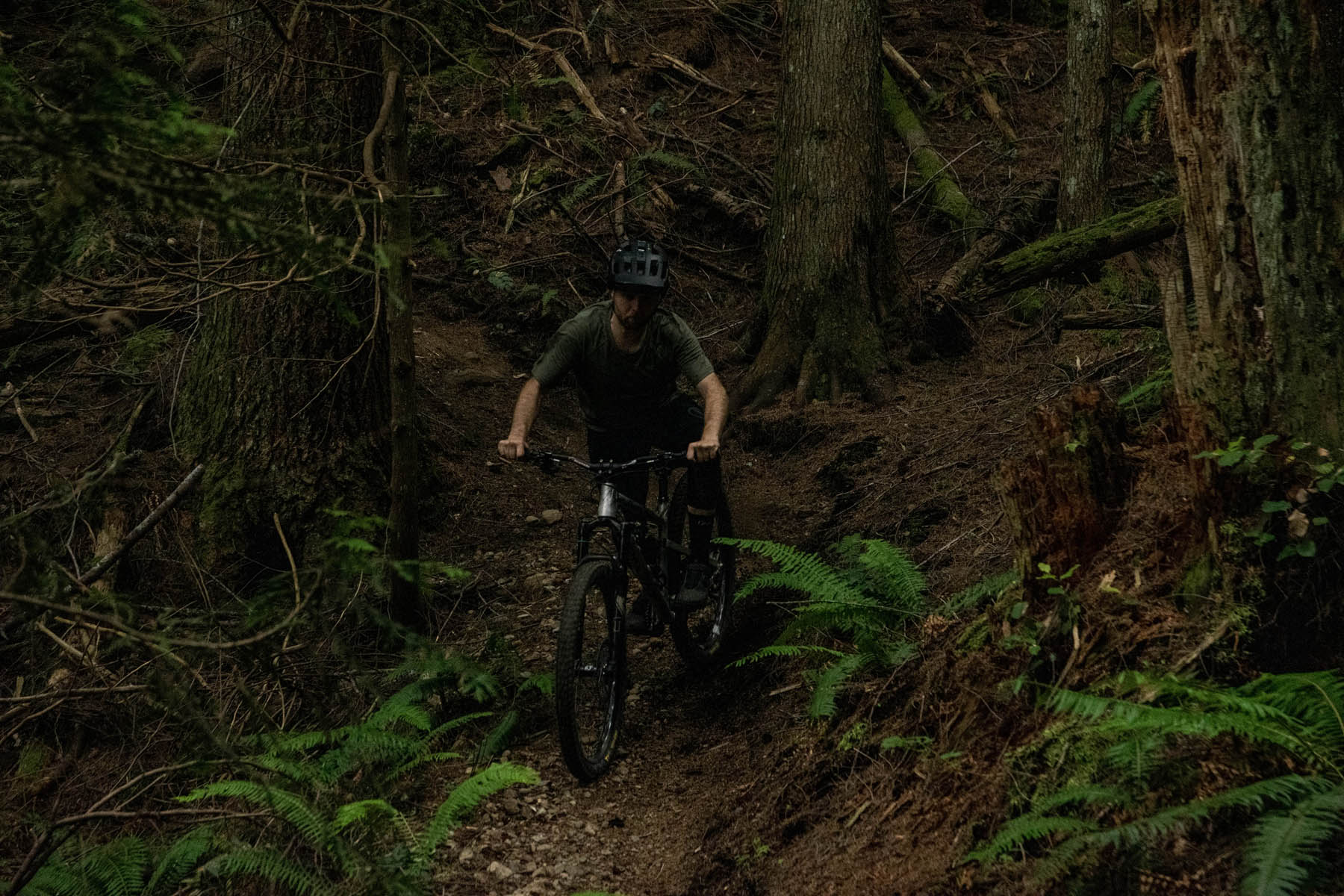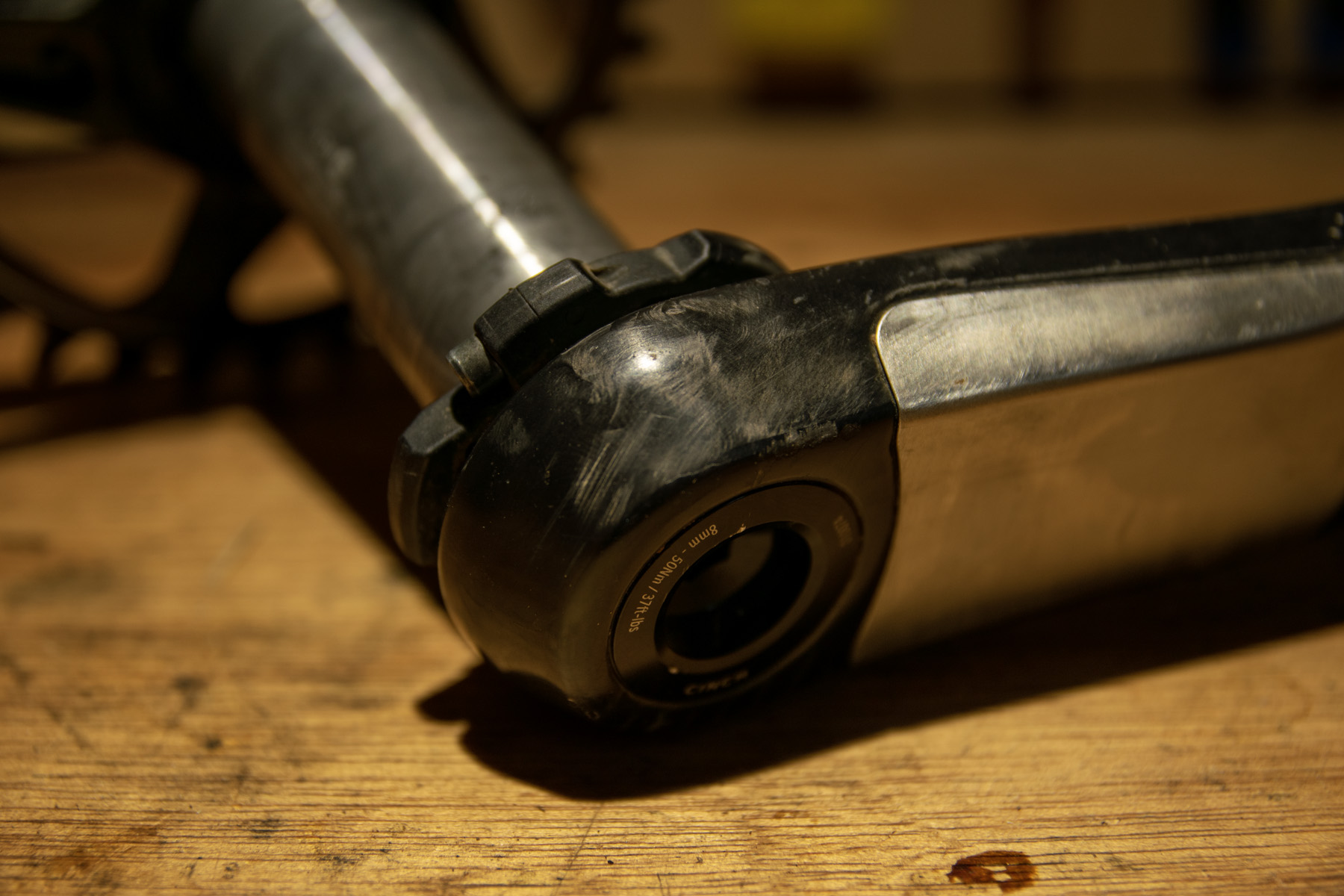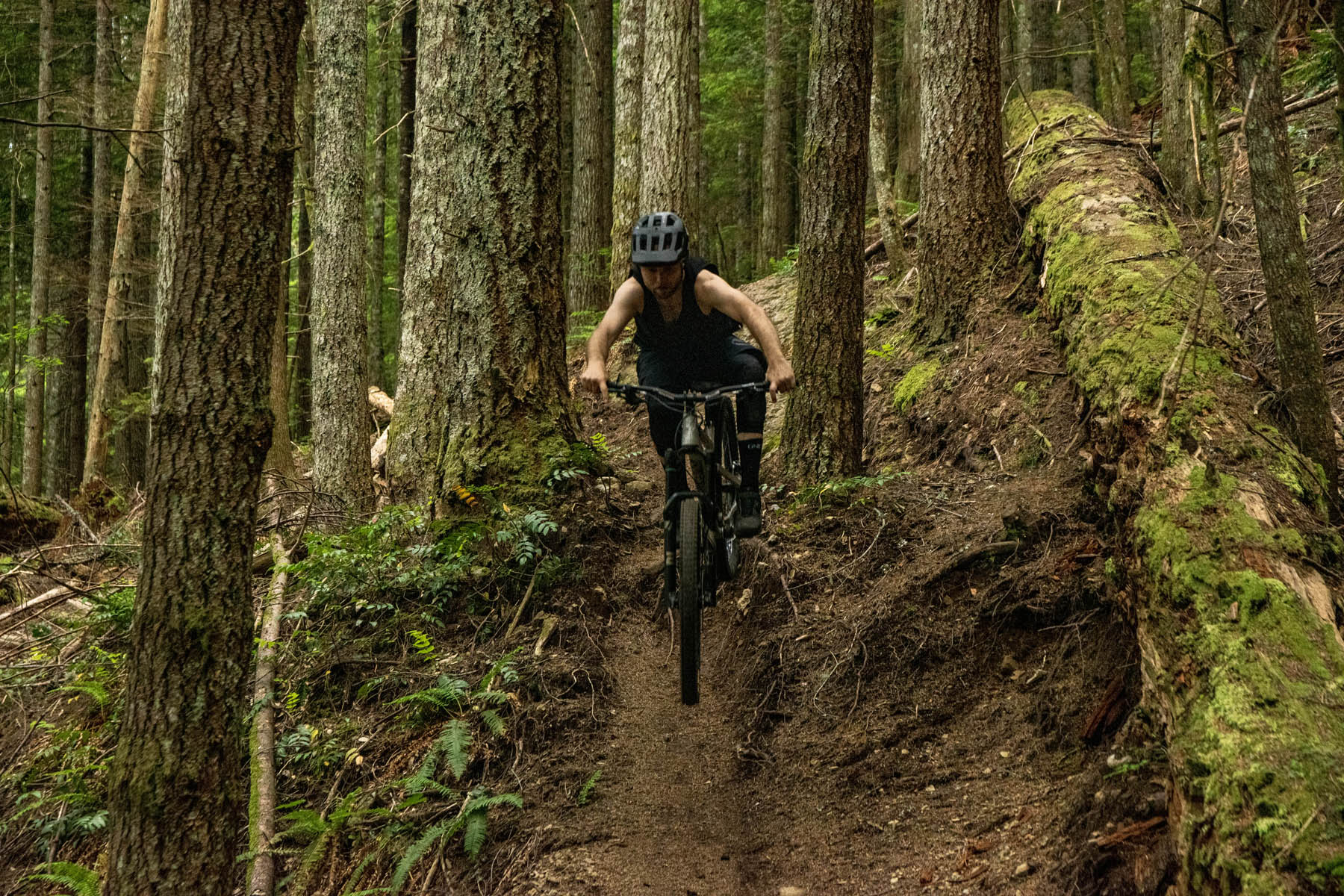Race Face Era Crankset
Reviewer: 6’, 175 lbs / 183 cm, 79.4 kg
Test Locations: Washington, British Columbia
Test Duration: 11 months
Intended Use: Trail & All Mountain
Lengths Offered: 165, 170, and 175 mm
Configuration Tested: 170 mm length; BSA bottom bracket; 32t direct mount ring
Blister’s Measured Weight:
- Cranks only: 415 g
- Bottom Bracket (BSA threaded): 92 g
- 32 tooth direct mount ring: 80 g
- Total:
- Crank and chainring: 495 g
- Crank, chainring, and bottom bracket: 587 g
MSRP: $499 (crank arms and spindle only)
Mounted to: Nicolai G1 and BTR Ranger

Intro
Carbon cranks have long been a viable way to save a substantial amount of weight on a bike, but their durability has often left a lot to be desired, particularly in the bonding between the carbon fiber arms and the aluminum inserts that are needed to support the pedal and spindle interfaces. But with Race Face’s latest carbon crank, the Era, they claim to have greatly improved the bonding strength between those inserts — and they’ve got some other tricks up their sleeve, too.

Design
The basic layout of the Era cranks will be familiar to anyone who’s dealt with a Race Face Cinch crank, going back quite a few years now. They use a 30 mm diameter spindle with a splined interface and a self-extracting bolt on the drive-side arm to remove the cranks; the same direct-mount chainring interface that’s been used on their various Cinch cranks over the years carries over, and there’s still a threaded preload collar on the non-drive-side arm to keep things snug. The chainring lockring still uses the same 20-spline bottom bracket tool that Race Face has used since the inception of the Cinch layout (which came from classic cartridge bottom brackets before that). Both crank-fixing bolts now use an 8 mm Allen head, with the 16 mm Allen for the drive-side self-extracting ring carrying over; Race Face still includes with the cranks an adapter to turn an 8 mm Allen wrench into a 16 mm one.
But a lot of the details are new, and the most visually striking one is the addition of stainless steel wear plates on the faces of the crank arms. The idea is to put a much harder-wearing material, and one that doesn’t need any finishing to maintain its aesthetics, on the portions of the crank arm that tend to be subjected to heel rub, and it works great. Race Face has also beefed up the preload collar — a regular source of frustration on older Cinch cranks. The ring itself is bigger in diameter and easier to turn than the old version, and the pinch bolt that locks it into place now uses a 3 mm Allen head with much deeper insertion than the easily stripped one on the older preload rings.

Race Face is pretty tight-lipped about the exact details of how they’ve beefed up the Era’s aluminum inserts (or probably more accurately, the interface between them and the carbon arms) but says that they have done so. They’re certainly talking a big game about the Era’s durability, claiming that they’re “the last carbon cranks you’ll need to buy” and that they’ll “outlast your bike.” To back that up, Race Face offers a lifetime warranty — including crash damage — on the Era cranks.
The Era comes with a 136mm-long spindle that’s meant for 68 and 73 mm threaded bottom bracket shells, as well as BB92 and PF30 68 and 73 mm ones (i.e., most bikes with a Boost rear end) but longer spindles are available separately for other configurations, including Super Boost bikes that require extra chainstay clearance. With the standard spindle, the Era gets a 52 mm chainline with standard chainrings, or 55 mm with the wide versions. The Era cranks have a 176 mm Q-factor with the stock 136 mm spindle, including pedal washers. Rubber crank boots are included with the cranks and match the chosen decal color, with seven options to pick from.

At 415 grams for the arms and spindle, the Era is notably light for an Enduro-rated crank. Here are our measured weights for a variety of its competitors, all in the same 170 mm arm configuration unless otherwise noted.
- Race Face Next R: 409 g (carbon)
- Race Face Era: 415 g (carbon)
- Race Face Turbine: 532 g (aluminum)
- Shimano XT: 536 g (aluminum)
- Hope Evo: 575 g (aluminum)
- SRAM X0 T-Type: 582 g (aluminum)
- NSB Talon: 659 g (aluminum, 165 mm arms)
On The Trail
First things first: I’ve broken a bunch of Race Face Next R cranks (the model that the Era effectively replaces) and at least one SixC crank over the years. After nearly a full year of regular use, the Eras are holding up great. The pedal and spindle inserts are tight, there’s barely any visible wear on the arms, and they’ve been quiet and creak-free.
And that really feels like the biggest part of the story here — it does seem like Race Face has made some big improvements to the durability of the Era cranks as compared to their earlier carbon offerings, and that’s a welcome update. Are the Eras stiffer than the Next Rs that they replaced? I don’t doubt Race Face when they say so, but I’d be hard-pressed to tell any difference on the trail. The Eras definitely feel stiffer than a lot of aluminum cranks — most noticeably when bolted up to my hardtail, where they do feel like they transmit a little more feedback to my feet than something like the Hope Evos — but for the most part, they’ve just done their job quietly and without drawing attention to themselves.
It’s relatively subtle, but the wider-than-average Q-factor of the Era cranks is noticeable, and while it hasn’t given me any major issues, I’d generally prefer it to be a little narrower. For reference, the Era (with the standard spindle) comes in at 176 mm; a Hope Evo crank in an equivalent configuration comes in at 167 mm, though that’s notably narrow. A Shimano XT M8120 crank is 172 mm wide, the new SRAM T-Type ones are 174 mm, and the new NSB Talon that I just started spending time on is stated at 171.4 mm. All of that is to say that the Eras are wider than average, but not by that much; if I was exclusively riding them I’d probably get used to it and never think about the Q-factor again, but in a world where I’m switching back and forth between the Era and narrower options (especially the Hopes), the first few minutes of pedaling the Eras feels just a touch less natural.

Still, that’s just me — your biomechanics are almost certainly different in one way or another — and if I was just riding the Era I could also probably move my cleats a little bit outboard to shift my feet in a touch to compensate. If you know that you care, take the extra Q-factor into account; most folks probably don’t need to worry about it.
Overall, the Era cranks have just worked. They’re light, stiff, look great (and keep doing so, with the stainless steel wear plates nicely protecting the arms from wear), and all indications are that Race Face really has taken great strides in improving their durability as compared to earlier carbon crank offerings. If you’re inclined to spend the money for the weight savings of carbon cranks, they’re a great option.
Bottom Line
Race Face’s carbon cranks haven’t always had the best durability track record, but the Eras I’ve been riding for quite some time now have put up with a whole lot of abuse without complaint. They don’t come cheap, and I’d personally love a slightly narrower Q-factor. But they’re very light, have held up great, and look really good doing it — especially for heel-rub-prone folks who tend to destroy the finish on their crank arms. I had given up running carbon cranks on my personal bikes years ago when I got tired of warrantying them, but I’ve been happily running the Eras for nearly a full year now on my personal Enduro bike, and would gladly keep doing so.

I appreciate the comments about Q Factor. I’m larger than the typical rider at 6’3″ so it stands to reason that a wider Q factor would be more comfortable for me…and that has been my experience. I move my cleats fully inward to effectively increase my stance width. I could use a bit more width still.